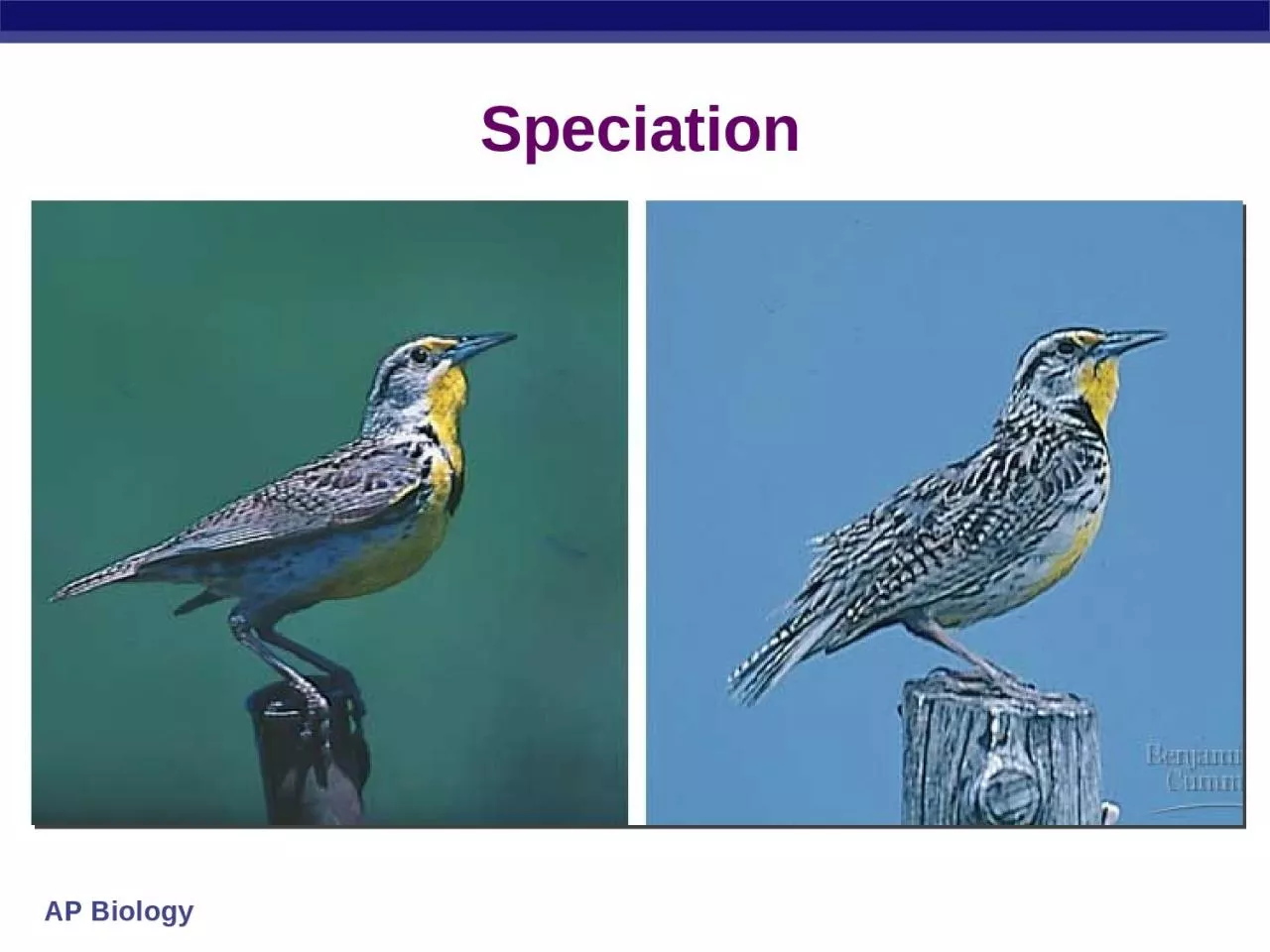

Populations must become isolated Reproductive isolation is key Once isolated populations will evolve independently different factors affecting each Two types of speciation allopatric geographic separation ID: 933398
Download Presentation The PPT/PDF document "Speciation How do new species originate?" is the property of its rightful owner. Permission is granted to download and print the materials on this web site for personal, non-commercial use only, and to display it on your personal computer provided you do not modify the materials and that you retain all copyright notices contained in the materials. By downloading content from our website, you accept the terms of this agreement.
Slide1
Speciation
Slide2How do new species originate?
Populations must become isolated
Reproductive isolation is key!
Once isolated, populations will evolve independently (different factors affecting each)
Two types of speciation
allopatric
geographic separation
“
other country
”
sympatric
still live in same area
“
same country
”
Slide3Reproductive Isolation
2 Main Types
Prezygotic
(before zygote)
Postzygotic
(after zygote)
Slide4Obstacle to mating or to fertilization if mating occurs
Prezygotic barriers
behavioral isolation
geographic isolation
ecological isolation
temporal isolation
mechanical isolation
gametic isolation
Slide5Geographic Isolation
Species occur in different areas
physical barrier
allopatric speciation
Ammospermophilus spp
Slide6Ecological Isolation
Species occur in same region, but occupy different habitats so
rarely
encounter each other
reproductively isolated
2 species of garter snake,
Thamnophis
, occur in same area, but one lives in water & other is terrestrial
lions & tigers could hybridize, but they live in different habitats:
lions in grasslands
tigers in rainforest
sympatric speciation
Slide7Temporal isolation
Species that breed during different times of day, different seasons, or different years cannot mix gametes
reproductive isolation
sympatric speciation
Eastern spotted skunk (L) & western spotted skunk (R) overlap in range but
eastern
mates in
late winter
&
western
mates in
late summer
Slide8Behavioral isolation
Unique behavioral patterns & rituals isolate species
identifies members of species
attract mates of same species
courtship rituals, mating calls
reproductive isolation
Blue footed boobies mate only after a courtship display unique to their species
sympatric speciation?
Slide9Mechanical isolation
Morphological differences can prevent successful mating
reproductive isolation
Even in closely related species of plants, the flowers often have distinct appearances that attract different pollinators.
These 2 species of monkey flower differ greatly in shape & color, therefore cross-pollination does not happen.
sympatric speciation?
Plants
Slide10Mechanical isolation
For many insects, male &
female sex organs of
closely related species do
not fit together, preventing
sperm transfer
lack of “fit” between sexual organs:
Animals
Slide11Gametic isolation
Sperm of one species may not be able to fertilize eggs of another species
Sea urchins release sperm & eggs into surrounding waters where they fuse & form zygotes. Gametes of different species—
red
& purple —are unable to fuse.
sympatric speciation?
Slide12Post-zygotic Barriers
Prevent
hybrid offspring
from developing into a viable, fertile adult
1. Reduced hybrid viability
2. Reduced hybrid fertility
3. Hybrid breakdown
zebroid
Slide131. Reduced hybrid viability
Genes of different parent species may interact & impair the hybrid’s development
Species of salamander genus,
Ensatina
,
may interbreed, but most hybrids do not complete development & those that do are frail.
sympatric speciation?
Slide14Mules are vigorous, but sterile
2. Reduced hybrid fertility
Even if hybrids are vigorous
they may be sterile
chromosomes of parents may differ in number or structure & meiosis in hybrids may fail to produce normal gametes
Donkeys have 62 chromosomes
(31 pairs)
Horses have 64 chromosomes
(32 pairs)
Mules have 63 chromosomes!
Slide153. Hybrid breakdown
Hybrids may be fertile & viable in first generation, but when they mate offspring are feeble or sterile
In strains of cultivated rice, hybrids are vigorous but plants in next generation are small & sterile.
On path to separate species.